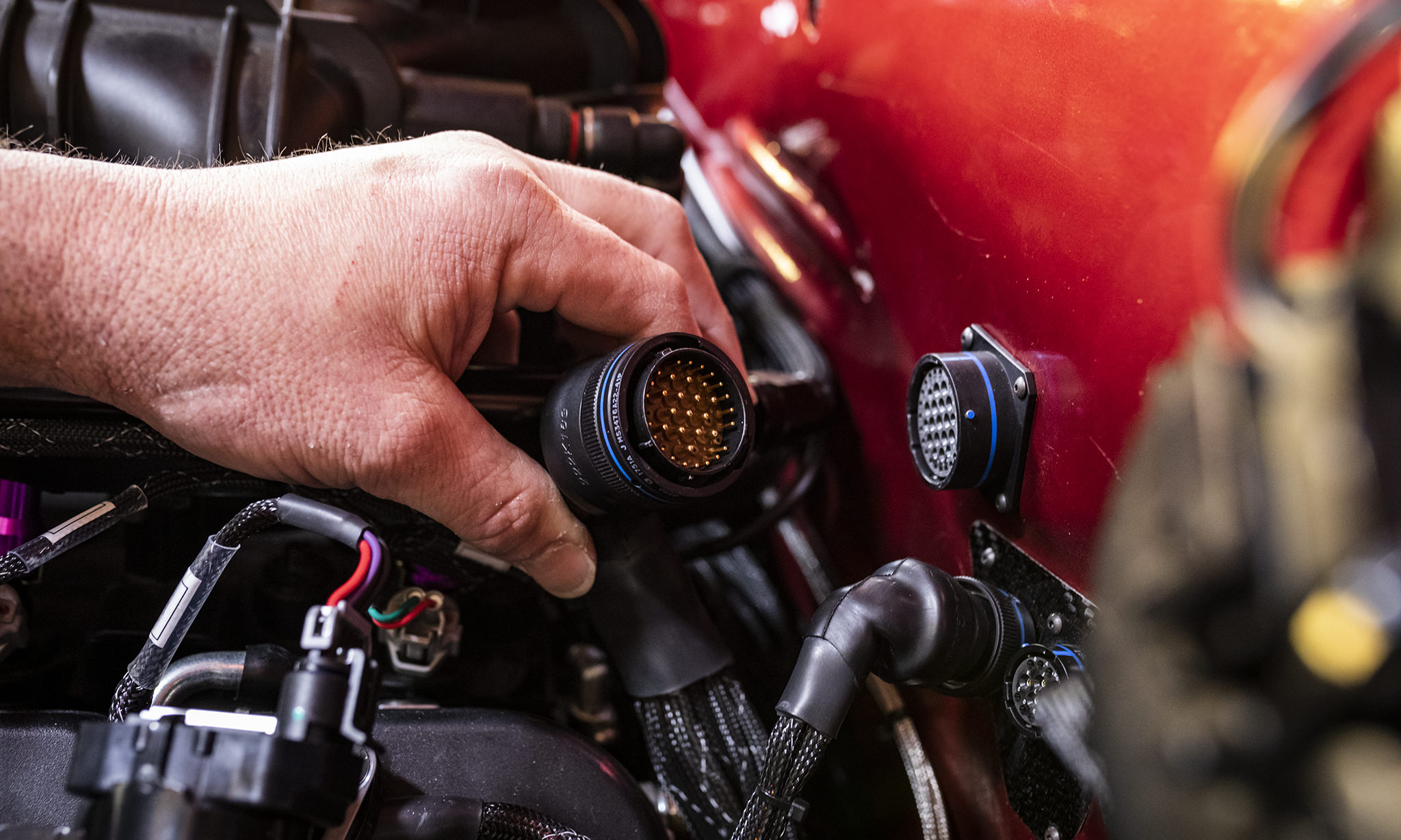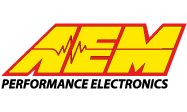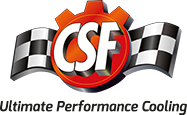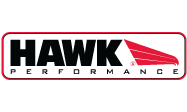Vehicle electronics systems used in performance applications can be incredibly complex, and RACEWires’ proprietor Troy Baum says that paying attention to the particulars is the most critical step to ending up in the winner’s circle. Let’s not get ahead of ourselves—before we begin discussing those details, let’s dig into a bit of background for Troy and how he got here from there.
“I’m a licensed plumber, but I’ve always played with Mustangs, street rods, and hot rods. After my day job was done, I would work on cars on the side, on the evenings and weekends. We started to wire some things up, so I stuck my head in the game, learned how to do it little by little in the evenings and on weekends, and it’s gradually turned into what it is today,” says Baum.
As he began receiving more phone calls for his services, he began studying—a few hours every night—as there was no school to attend at the time where he could learn the basics of how to properly design motorsports wiring.

“I sought out my own education; I went onto manufacturer’s websites, downloaded the installation manuals, printed them out, and studied. I read those manuals every day, for years,” he explains.
“I approached my research like a college student would, except I didn’t have to pay high tuition costs. I kept that same discipline; when the workday was done, I would just stay up and read every day. Now, I’m home and I read for ten minutes and I fall asleep.”
The RACEWires shop, located in Lancaster County, PA, is in a spot which is kept semi-secret for a number of reasons. You can’t even find it on the RACEWires website. Heck, when I went to visit, I couldn’t find it, and I had the address!
That’s by design, as Baum—one of the most meticulous and particular people I’ve ever met—has a process he’s developed over the last several years which is designed to do one thing: get his customers into the winner’s circle. Doing so requires a level of focus many people would struggle to achieve, and if he were to publish the address, he fears that the resulting focus on the company, unexpected visitors, and other distractions would hinder his workflow and potentially cause issues.

You’ll hear me mention The Process several times throughout this article, and it’s not because I’m a fan of the Philadelphia 76ers (even though I am); it’s because Baum’s process is one which has proven successful, with many heavy-hitter drag racers from all over the eastern United States and Canada lined up for his services. In fact, he usually runs a backlog of several months to get a car into the shop for a complete wiring package.
Many champions and race winners have come out of his shop over the last several years. Recently, Brian Chin took home the title of Second Chance race winner in the Radial Vs. The World class at Lights Out X. Additionally, he completed a full vehicle integration for Ernie Pompilio out of Canada, whose ’67 GT500 Outlaw 10.5 car is one of the prettiest you’ll see anywhere.
The famous Racin’ Jason Mustang of Joe Caldwell also spent time in the shop having all of its particulars sorted out, along with Cal Hayward’s ‘Pinky’ twin-turbo Mustang, which won the 2017 Drag Week Super Street small-block power-adder class. Even Lights Out 9 X275 winner John Keesey has gotten in on the RACEWires treatment.


“We also hold the PDRA Pro Nitrous record with Jim Halsey’s Pro Mod along with the NMRA Coyote Stock championship with Darin Hendricks and former Cecil County Outlaw 10.5 champ Mo Hall,” says Baum.



Setting one of these cars up for success can take 80–160 hours from start to finish, depending upon the level of integration which is required. Before ever touching a single wire, or ordering a single component, extensive consultation with the vehicle owner takes place. As RACEWires specializes in—but does not limit itself to—wiring and electronics integration for upper-echelon drag race machines, there is often a long list of components which must be chosen specifically for the capabilities they offer. Making sure the vehicle has been optimized so that each of those pieces talks properly to the others in the chain, recording data, firing coil packs, opening and closing fuel injectors correctly, and more… that’s where The Process comes into play.

When I went to visit RACEWires, the first thing I noticed when I walked into the shop was the giant whiteboard he has hanging on the left side of the shop. It had a list of components, notes, and diagrams relating to the engine management system, engine sensors, and other electronic products which were to be installed into Dan Smith Jr.’s Outlaw 10.5 car, which is raced at Cecil County Dragway and other East Coast events throughout the year.

Just one wire out of place, or one connection which isn’t secure, is the difference between winning and losing. In many cases, the car isn’t even complete when Baum works on it, yet he’s tasked with ensuring every component does its job correctly. When the stakes are high—several of his customers compete in classes which pay six figures to the winner—the racer simply can’t afford a failure.
That’s a sentiment which sticks in Baum’s mind, every time begins to lay out a project.
“Early on that didn’t sit well with me, and I still get an anxious, nervous, butterfly kind of feeling. Fortunately, when the cars leave usually we’re spot-on. I run the whole job through my head first. I have to stand back and think ‘what’s the process they’re going to go through to finish this car, and what’s my involvement in that process?’,” he says.



This mil-spec firewall connector has 52 available pins, each of which has to be mapped out, and then wired appropriately. There’s a male and female side to this connector, which means potentially 104 connections just at this location. Baum uses one of these whenever possible to facilitate easy engine removal for racecars; simply twist the connector and pull it apart from the firewall-mounted side, then the whole engine can be removed. It’s a tedious task just to assemble one of these, and requires attention to detail which would cause many builders to wilt.
“I write down all of the sensors I need in the engine bay, and then I can go in and fill the pins. I format it this way so we know which pins control which components. I have to keep it in order because it’s easy to lose track of where you are,” he explains.




Smith recently performed a bunch of upgrades to the car and had dropped it off to RACEWires to have the whole car rewired, along with a brand-new FuelTech FT600 engine management system and Davis Technologies Profiler Wheel Speed Management System installed. Each of these components performs a different function in the car, and organizing the electrical current to pass correctly from one to the other is the main part of The Process. In order for Baum to make all of these things happen properly, that white board I mentioned earlier is the first step, but certainly not the last. For example, more than one component may need to have a driveshaft RPM signal, which requires Baum to split that signal where necessary.




I won’t profess to know which gauge wire is required for each type of wire; I’m not an electrical engineer. What I do know is that when Baum works through the process of laying out a car’s configuration, his years of experience and fanaticism for doing the job just so comes through immediately. He knows which type of wire works best for each application; with this knowledge, he works through the layout and configuration to ensure that the finished product looks as good in the vehicle as it does in his mind’s eye.




Some of the tools of the trade include various types of wire strippers, cutters, crimpers, and pin installation tools. Razor blades are helpful as well. Also seen here are terminal connectors, pins, labels, and heat-shrink overlays. Every wire receives a label at each terminal end. Random fun fact: Troy has several old-school skate decks hanging on the wall to provide motivation.



Troy made these harnesses for Manny Buginga’s second car, seen in the background of the photo. That one hasn’t debuted yet, but is coming soon. It’s helpful for the car owner/chassis builder/fabricator to have components installed in their final position to simplify harness fabrication.

De-assembly (such as the pile of wire seen above) must often be performed before he can start the process of integrating the new pieces into the process. Many cars come in plagued by electrical gremlins caused by years of field wiring repairs, the use of factory harnesses, and other factors.

Throughout the workflow, cleanliness and organization is the main ingredient which helps Baum to be so successful. He’s so meticulous that even all of the wire ties he uses to secure bundles are oriented in the same direction.



Since the language of wiring is nearly universal, Baum also has plenty of jobs which are not traditional drag cars. This installation is on his own LS-swapped turbo Mustang, which makes use of one of Haltech’s 2500-series engine management systems and a digital dash display unit from AiM Tech. Check out the relay arrangement hidden in the glovebox!




Consumables are a big part of shop area at RACEWires; Baum has to keep stock in hundreds of part numbers of specific types of pins, connectors, and terminal ends. Each type works for a particular connector type only, and each car requires something different.
It has been a successful strategy for the Philadelphia 76ers to rebuild their basketball team using a measured, steady, and consistent process of drafting and signing quality players to win games. The strategy is the same for Troy Baum and RACEWires; use a similar approach, with thorough preparation and dedication to perfection. Laying the proper groundwork is what puts racers into the winner’s circle, and that’s what drives Troy Baum to cultivate and refine his craft.









